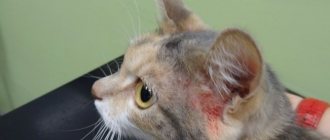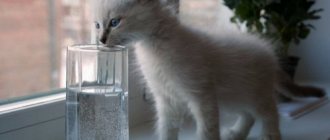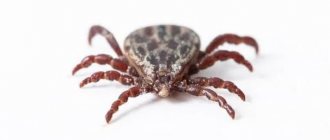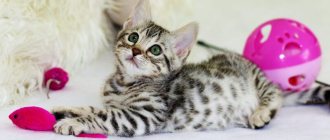9637Pavel
2
A cat, like a person or dog, has a normal temperature. Only in the mustachioed pet it is significantly higher than in humans. So, for an adult cat the norm is 37.8-39.2 degrees, and for a young animal 38.3-39.7 degrees. However, a cat may have a low or high temperature. Today we will talk specifically about low body temperature, which is also called hypothermia. It is typical mainly for small kittens and older individuals.
Experts divide hypothermia into 3 types:
- mild – body temperature fluctuates between 32-35 degrees;
- moderate – 28-32;
- deep - below 28 degrees.
© shutterstock
Normal indicators
If a person's temperature is considered normal at 35.9 to 37.2 °C, then in a cat they are always higher - 38-39 degrees. There is an opinion that the normal temperature for representatives of hairless breeds is 42 °C.
In fact, for sphinxes it is the same as for long-haired cats. It's just that your pet's skin always feels hot when touched. It is not surprising, because there is no fur on it.
A slight increase in temperature in cats is always observed during the hot season. Indicators may vary throughout the day. So, during sleep and in the morning after waking up they are lower, but after physical activity, eating and in the late afternoon, on the contrary, they are increased. There's nothing wrong with that.
A temperature jump of 1 degree upward during estrus, pregnancy, childbirth, and also after sterilization or vaccination should not cause concern.
It should be noted that in kittens the mechanism of thermoregulation is formed gradually. In newborns, the readings are considered normal: 35.5 to 36.5 ℃; in babies 1-2 months old, they range from 38.5 to 39.5 degrees. Once the kittens reach 7 months of age, the indicators stabilize.
Antipyretic for cats
If our advice did not help you, and you do not know how to lower your cat’s temperature before the veterinarian arrives, call the doctor, maybe he will allow you to use antipyretics before his visit. The main rule is to never give human medications to cats.
A cat's temperature can be reduced with the following medications:
- Tsefekon - candles.
- Papaverine and diphenhydramine - injections.
- Echinacea – tincture.
- Meloxicam - tablets.
All these drugs, as well as others, can be given only on the recommendations of the treating specialist.
Causes of hyperthermia in cats
An increase in body temperature in a pet can be caused by a variety of reasons. The most common of them is ordinary overheating. If the cat has been in the sun or in a stuffy room for a long time, the readings can jump up to 41 degrees.
To stabilize the temperature, it is enough to place the animal in a cool room and give it water to drink. As a rule, after a couple of hours thermoregulation returns to normal.
Temperature can also rise significantly due to stress. Cats are emotional, and the appearance of another pet in the house, moving to a new place of residence, changing or losing an owner, even a banal trip by car to the veterinary clinic causes them great anxiety.
The animal's condition will stabilize as soon as it feels that it is not in danger and its loving owner is still nearby.
Hyperthermia can be triggered by infections. In such cases, the pet experiences symptoms such as diarrhea, vomiting, urinary retention, lack of appetite, and weight loss. Infectious diseases are very dangerous and require immediate attention to a veterinarian.
If a cat's fever is accompanied by sneezing, mucous discharge from the nose, and lacrimation, we are most likely talking about infection of the body with a virus. In such cases, it is also necessary to visit a veterinary hospital.
A high temperature can be caused by an inflammatory process occurring in the body, such as mastitis. There are often cases when impaired thermoregulation is a sign of cancer.
Causes of hypothermia
There are many reasons for hypothermia:
- Hypothermia. A common cause for cats that walk outside. The temperature decreases due to the physical transfer of heat to the external environment. Frostbite can be an additional problem.
- Infectious or viral disease. There are two possible developments. The first option is a slowdown in metabolism (as a result of intoxication). The second option is inflammation of the brain, hypothalamus (responsible for temperature). Often accompanied by symptoms such as diarrhea, cough, shortness of breath.
- Low blood pressure. Because of this, the oxygen supply to tissues deteriorates. As a result, metabolism slows down and temperature drops. A decrease in pressure is easily determined by a tonometer.
- Starvation. Because of it, metabolism slows down and temperature decreases. With severe exhaustion, other symptoms appear: cardiovascular disorders, alopecia, weight loss, and in severe cases, atrophy of internal organs and muscles.
- Anesthesia. Because of it, the temperature drops, as the brain turns off, along with the hypothalamus and the thermoregulation center. After the animal comes to its senses, the symptoms disappear, but with deep and long-term anesthesia, medical assistance will be required.
- Cancer. Because of this, the main part of the nutrients goes not to healthy cells, but to tumor cells. Due to a deficiency of substances, metabolism and temperature drop. More often, such signs appear in the later stages, when the main problem is not hypothermia, but metastases.
- Kidney diseases. Intoxication leads to metabolic disorders and a decrease in temperature. Often the disease is accompanied by problems with the liver, urination, and cardiovascular system.
- Heavy bleeding. As a result, blood pressure drops, oxygen supply to tissues deteriorates, metabolism slows down, and temperature drops. Additional signs are anemia and bleeding itself.
- Metabolic disorders. It becomes a consequence of a deficiency of various vitamins, amino acids, fats and minerals. Alopecia, stunted growth, curvature of bones, and cardiovascular disorders are often added to the symptoms.
- Vitamin deficiency. As a result, metabolism is disrupted. This leads to a decrease in metabolism. Additional symptoms include alopecia, curvature of bones, digestive and urinary problems.
- Poisoning. They lead to a wide variety of consequences. Often accompanied by diarrhea, vomiting, cardiovascular and respiratory disorders, and pathologies of the nervous system.
- Dehydration. The decline begins with severe dehydration, when blood pressure drops. Additional symptoms are dry mucous membranes, sunken eyes, lack of shine in the coat, and weakness.
- Heart diseases. Because of them, blood circulation is disrupted and the supply of oxygen to tissues is reduced. This is often accompanied by low blood pressure, chest pain, swelling, and blue discoloration of the mucous membranes.
- Enteritis. The temperature drops in severe cases, when the integrity and function of the intestine is severely impaired, cardiovascular pathologies, intoxication, and dehydration appear.
- Diseases of the nervous system. Hypothermia appears if the hypothalamus and thermoregulation center are involved in the pathological process. Often accompanied by a variety of abnormalities in the functioning of the central nervous system.
How to measure a cat's temperature correctly
The four-legged pet's temperature should be measured rectally with a thermometer. There is no point in measuring under the foot, as the result will be incorrect.
Many owners prefer to use an electronic thermometer as it is the safest. A regular mercury thermometer will also work, but it is very fragile and therefore unsafe. Therefore, it is advisable for cat lovers without experience to resort to the first option.
It is rare that a cat will not resist when trying to measure its temperature, so it is advisable to carry out the procedure, which is painless but slightly unpleasant, together. One person will hold the animal, the second will perform the manipulation.
Measuring a cat's temperature:
- Place your pet on a hard, horizontal surface, tummy down.
- Lubricate the tip of the thermometer with Vaseline oil.
- Lift the cat's tail, carefully, twisting, insert the thermometer into the anus about 1 cm (for kittens - 0.5 cm).
- For accurate measurements, hold the thermometer for at least 5 minutes, regardless of whether it is mercury or electronic.
- After the procedure, wipe the thermometer with alcohol.
You can take your cat's temperature with an infrared ear thermometer. The procedure is absolutely safe and painless, in addition, the device will show the result in a maximum of 10 seconds. However, if an animal has an inflammatory process in its ear, the results will be unreliable.
Inexperienced pet owners prefer to determine the cat's temperature by looking at the nose: if it is wet and cool, then everything is in order with the pet's health. But if the nose is dry, then this indicates poor health, including a possible increase in temperature.
You should not rely on this method, because a cat that has just woken up from sleep will always have a dry earlobe. But you can touch the ears. If the cat's temperature is above 41 degrees, then they will be hot.
First aid
Depending on the degree of hypothermia, the actions taken will differ:
- Mild hypothermia. Manifested by muscle tremors, rapid pulse, pale skin and mucous membranes. The animal is revived by external heating using heating pads and towels. The pet is also given warm broth to drink.
- Moderate hypothermia. In this case, the skin becomes pale with a marbled tint, while muscle tremors are not observed. The pulse is weak, rare, breathing is shallow. External heat sources are used for warming. However, they may not give the desired result, so it is recommended to use Roncoleukin and do warm enemas. Do not overheat to avoid causing tissue damage.
- Severe hypothermia. Severe rigor, the pulse becomes weak, breathing is barely visible, the animal is unconscious, there is no reaction of the pupils to light. At this point, you should at least wrap your pet in a warm towel. However, this often does not give the desired result; you need to make a warm drip as soon as possible.
Below we will consider each type of manipulation in more detail.
Passive warming
This is a primitive way to warm an animal. Helps with mild to moderate hypothermia.
To do this, do the following:
- blow dry and wrap in a warm towel;
- put the pet on a heating pad, into which pour water at a temperature of 39 C;
- the pet is given warm broth (not milk or vodka);
- After the temperature returns to normal, the cat is given a handful of food.
Warm enema
For an enema, you need an isotonic 0.9% saline solution with a temperature of 40 C. It is taken into a bulb with a volume of no more than 100 ml. It is better to carry out the procedure together, so that one person fixes the pet, and the other does the necessary manipulations. Most often, with hypothermia, cats are passive and easily agree to treatment. However, if the cat is fighting, wrap it tightly in a towel, leaving its hind legs and tail outside.
Due to the fact that a deep enema is being performed, it is better to place the animal on its left side, so it will be much more comfortable for them. To prevent your pet from injuring its owner with its claws, hold its hind legs by the area above the knees. Before administration, the tip of the enema is lubricated with Vaseline. Inject carefully, with rotational movements to a depth of 1-1.5 cm and parallel to the spine. Next, gradually press the bulb so that the solution passes into the rectum slowly.
"Ronkoleikin"
The administration of this drug is an effective, simple and safe method of treatment. "Roncoleukin" is a solution for oral, external and injection use. For hypothermia, it is first administered subcutaneously. When you feel better, the medicine is taken orally.
The composition of the drug includes:
- human interleukin-2;
- sodium dodecyl sulfate;
- D-mannitol;
- dithiothreitol;
- ammonium carbonate;
- distilled water.
The animal is injected with 10,000 – 15,000 IU/kg. Practice shows that when Roncoleukin is combined with other procedures, it is possible to achieve an increase in temperature and save lives in 100% of cases. When using only Roncoleukin, this figure is also high - 90-95%.
If the pet's condition improves, it is recommended to re-use Roncoleukin in the next two days at the same dosage (once a day). The standard course of therapy is 3, less often 4 injections. The first administration is always subcutaneous, subsequent doses are administered with water through a syringe.
Additional symptoms
Fever in pets is often accompanied by apathy, lack of activity and decreased appetite. The animal may even refuse water and spend most of its time lying on its side. At the same time, the cat often hides from its owner in a secluded place where no one will disturb it:
- If your pet additionally has diarrhea and vomiting, this may indicate food poisoning or acute gastrointestinal diseases: ulcers, pancreatitis and liver damage. In this case, tachycardia may also occur, the animal’s fur loses its shine and falls off.
When the temperature rises, the pet often experiences apathy and lack of appetite.
- If the pet does not allow you to touch its belly and reacts to any attempt with a plaintive meow or aggression, then this behavior indicates pathologies of the abdominal cavity.
- When the temperature rises, you need to examine your pet’s skin. In the presence of sores, wounds and rashes, tick-borne encephalitis, lichen or severe allergic reactions can be suspected.
If the animal refuses water, it is important to immediately consult a doctor, as dehydration can cause death. This is especially necessary if the fever is accompanied by diarrhea.
Table with standards
| T/age | Up to 10 days | 10–30 days | month–10 years | Older |
| 35–37 | norm | normal/reduced | downgraded | downgraded |
| 37–38 | normal/increased | norm | downgraded | reduced/normal |
| 38–39 | Promoted | increased/normal | norm | norm |
| more than 39 | Promoted | increased | increased | increased |











